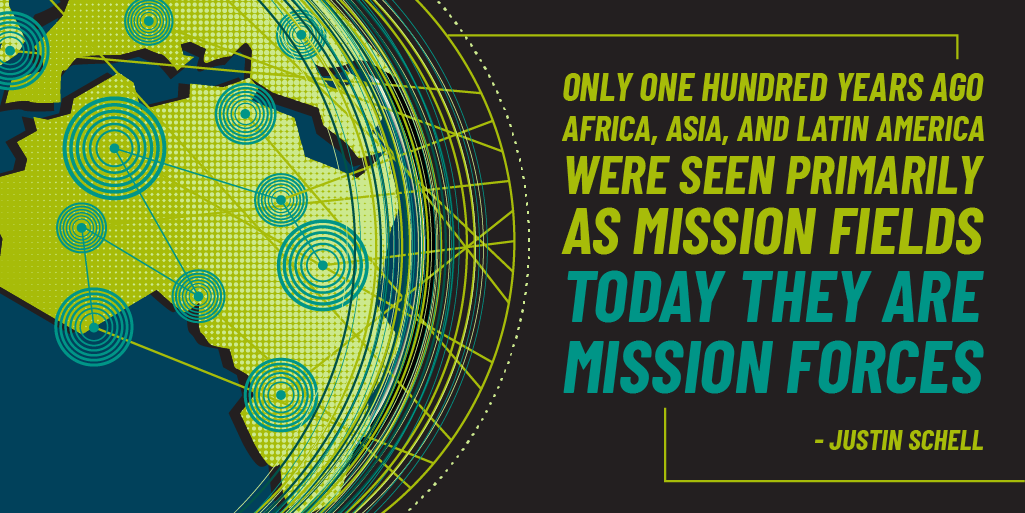In the past 100 years, the face of Christianity has drastically changed. What does this mean for believers globally?
I have a friend living in the London area. He recently shared a story with me that reflects the changing shape of the global church. He said, ‘Since I’ve lived in London, I’ve had three people approach me on the street to share the gospel with me. Two were from Africa and one from China.’ My friend has yet to have an English person offer Christ to him in such a way.
This experience is a small window into a larger reality in the world, namely, that the global church is primarily African, Asian, and Latin American. Today roughly 77 percent of evangelicals globally are from these continents. Further, it’s estimated that half of all Christians will be African by the year 2050. Much has changed since the days of David Livingstone.
It’s not just that Christian population numbers are higher in the Majority World. My friend’s experience also helps us see the transition to a new era in global mission. Once thought to be an enterprise ‘from the West to the Rest’, mission has become a global, polycentric activity, ‘from everywhere to everywhere’. Only one hundred years ago, Africa, Asia, and Latin America were seen primarily as mission fields—today they are mission forces. How did this happen? How did Christianity become such a global reality?

In one sense, Christianity has always been more diverse than the cultures around it. Recent works have highlighted what many church historians have known for some time—specifically, that Christianity started as a global movement and has always been one.
Perhaps my favorite illustration of the global nature of the historic church is Andrew Walls’ story of an intergalactic PhD candidate. An alien scholar has decided to travel to the Milky Way to study a phenomenon on a tiny planet called Earth—namely, a religion known as Christianity.
Because the lifespan of this student is significant, he is able to visit Earth several times over a two-thousand-year period. Each time, he visits what he believes to be the heartland of Christianity: first-century Jerusalem, fourth-century Nicaea, seventh-century Ireland, nineteenth-century London, and twentieth-century Nigeria.
Think of the cultural diversity (from Jews of the early church to believers from the dozens of peoples in Nigeria). Think of the range of theological emphases (from Messianic expectation in Jerusalem to robust Trinitarianism in Nicaea to the present power of the Spirit in West Africa). Think of the variety of worship and mission practices (from temple worship to Monastic asceticism and even abolitionist activism).
There is a diversity in the church through both space and time. The church has always been a diverse movement.
Still, in another sense, something new is going on. In a previous post, I pointed out the missional impact of the Reformation as it gave the Word of God, in vernacular translations, and the work of God, in the priesthood of all believers, back to God’s people. Imagine a world in which a shoe cobbler named William Carey doesn’t go to India to translate the Bible into several languages!
Carey’s work, which began in the late 18th century, would serve as a prototype for many more over the next 100 years. This led Kenneth Scott Latourette to call the 19th century ‘the great century’ in church history. He says,
Never before had Christianity, or any religion, been introduced to so many different peoples and cultures. Never before in a period of equal length had Christianity or any other religion penetrated for the first time as large an area as it had in the nineteenth century. Never before had so many hundreds of thousands contributed voluntarily of their means to assist the spread of Christianity or any other religion.”
That momentum continued, despite the devastation of two world wars, until, at the end of the 20th century, we could talk about a Korea that was approximately 25 percent Christian, as opposed to 1 percent Christian at the start of the century. That’s just one example of what Philip Jenkins calls The New Faces of Christianity. We live in a world where increasingly more Anglicans worship each Sunday in Nigeria than all Anglican and Episcopal churches in Europe and North America combined.
But again, Korean and Nigerian men and women are not only worshiping God, they are going out on mission. The Nigerian Evangelical Mission Association, with a roster of 15,000+ missionaries, has the stated mission: ‘To be a fellowship and networking platform for the Nigerian Church and Missions Movement towards completing the Great Commission.’ The Movement for African National Initiatives is working across the continent to achieve similar aims. In Latin American, Comibam is serving a similar role of mobilizing the church of Christ to engage in his global mission.
ARTICLE
Perspectives from Global South Christianity
Three scholars from Ghana, Brazil, and East Asia share key attributes and practices in their region.
Korea has been a top-10 missionary sending nation for some time now. Similarly, the mobilization of China’s churches for the unreached is perhaps well known. What is exciting is the movement across all of Asia to mobilize for the mission together. The Asia 2022 Congress was unprecedented in many ways. First, in its scope to mobilize across all of Asia. Second, it brought together Asia Lausanne, Asia Evangelical Alliance, and the Asian Theological Association for the first time. Third, the congress itself was preceded by years of coalition building and months of ongoing conversation and equipping on church planting and multiplication in Asia.
Perhaps most exciting, in my mind, is the fact that this is occurring across a region where persecution is growing. The 2023 Open Doors’ World Watch List for the fifty countries in the world in which it is most difficult to be a Christian includes most of Asia. Nigeria is also on this list.
Historically, the church has ebbed and flowed, often syncing with waves of persecution. I know of no other mobilization movement, in all of Christian history, to take place in the middle of systematic and widespread persecution. That’s not to dismiss the heroic faithfulness of martyred generations and those won to Christ by their fidelity, or those who have sacrificially moved to and ministered in lands violently opposed to the gospel. Nevertheless, the typical response to persecution is to remain steadfast in the faith, more so than to spread the faith.
This is a new era indeed in the history of God’s people. While space limits all that could be said about how to respond or move forward in this new reality, let me suggest three actions:

1. Praise the Lord.
Mission leaders and practitioners in previous generations dreamed of a day when the church would be established throughout the Majority World. What would Sung Shang Chieh think of the growth of the Chinese church today? How joyfully is Amy Carmichael celebrating the growth of the Indian church in heaven right now? Let’s join them. God has done great things!

2. Look locally/regionally
While global partnership in mission may be the goal, there is reason to reflect locally or regionally from time to time, so that the whole is healthier because of the parts. Majority World leaders are meeting together, feeling the need to steward the historic shift they have inherited and now lead. From theology to church practice to missions, we understand that spiritual health is imperative. Humble and urgent prayer, combined with a joyful submission to the supreme authority of Scripture, will be vital.
In the West, we see what might be called a retrenchment, a winnowing time where cultural forces no longer incentivize the faith. This loss of influence, coupled with shameful exposure of sin in the house of God, will hopefully result in a purified church, beautifully humble and holy, who will both shine all the brighter and become more servant-hearted in partnership with our global brothers and sisters.
ARTICLE
Are Foreigners Still Needed in the Age of Indigenous Mission?
Explore roles, strategies, and reflections for outsiders in local contexts.

3. Prepare for partnership.
We have learned much about partnership since the first Lausanne congress in 1974. We still have a mission, and we still need one another for success. We need lots of partnerships—local, regional, and global partnerships. Thin partnerships and thick partnerships. Compounding partnerships and complementary partnerships. Church partnerships, parachurch partnerships, and a combination. Lay and clergy, or what we call Nehemiah and Ezra, partnerships.
One of the driving activities within the larger Lausanne 4 process is the mobilization of thousands of collaborative action teams. These teams may be small or quite large. They may be local, regional, or global. What they all have in common is that they are seeking to fill a gap in the Great Commission identified by ongoing research leading up to the Seoul 2024 congress and beyond, even to the year 2050. The funding, communication, technology, and, frankly, humility it will take to help catalyze these teams is beyond what any network or movement can do on their own.
It is good news that the gospel is being proclaimed on the streets of London. It is marvelous to see the growth of the church in the Majority World. Let’s rejoice in these things.
And let us remember, with urgency, that there is still much to do. Much prayer. Much submitting to, being formed by, and heralding of God’s Word. There are still thousands of people groups with little to no access to the gospel. There is a need for renewal in the West and continued growth in the Majority World. There are hundreds of millions of Muslims, Hindus, Buddhists, and animists waiting to hear the gospel for the first time in their language.
There is a need for Christ-like leadership around the world. We need each other. And we will continue to need each other until the day we gather around the throne of heaven with brothers and sisters from every tribe, language, people, and nation (Rev 7:9).



